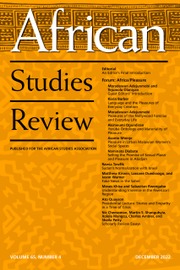People who depend on land for their livelihoods and scholars of agrarian studies have long recognized that land is both a means of production and a means of signification. Sweet Deal, Bitter Landscape continues this rich tradition by charting the trajectory of a large-scale land concession in Bagamoyo District, along Tanzania’s coast. Originally a private investment, the EcoEnergy Sugar Project became a transnational public-private partnership between a Swedish company and the Tanzanian government. Through a 99-year lease, encompassing over 20,000 hectares, EcoEnergy would produce sugarcane biofuels for European markets to combat global climate change, but over time the focus of the project shifted to domestic sugar production and agricultural development. The EcoEnergy project typifies the “new enclosures” of contemporary agrarian capitalism, whereby large corporations—foreign and domestic—lease land on long-term deals to the detriment of those who lose access to land and its resources. Though the scale of the venture was unprecedented in Tanzania, by 2016 the government had canceled the project, not to safeguard residents whose land rights and livelihoods were jeopardized by it, but rather to protect wildlife in the national park adjacent to the concession area.
Chung carried out ethnographic research across the investment concession between 2013 and 2016, with additional fieldwork between 2018 and 2020. In addition to ethnographic methods and archival research, she also draws on photovoice and participatory visual methods, which allowed her interlocutors to depict aspects of their lives and landscapes important to them. At the center of her robust ethnography is how residents’ lives and livelihoods became deeply entangled with the project. Though the EcoEnergy project ultimately collapsed, residents living within the concession area did not experience it as a failure. Instead, over the course of the project’s lifespan, residents lived with a pervasive sense of uncertainty regarding their land use rights, their livelihoods, and their future security. Its failure on paper and inability to materialize did not erase the residents’ experiences of precarity. Crucially, the book examines how liminality is produced through relationships between the state, corporate, and nonstate actors across different scales and temporal moments. As such, it addresses how liminality becomes normalized in between the time of land acquisition and capital accumulation. The book adds to our understanding of liminality not as a moment of stasis or the unraveling of the everyday social order, but rather as a dynamic and contingent condition that is refracted through gender and other interlocking identities, as residents navigate the contours of the land deal and its related actors.
The book is organized with an introduction, six substantive chapters, and a conclusion. Much of the book’s detailed ethnographic evidence centers on what Chung terms “everyday acts of presence” (56), or the way residents remain on the land in the face of uncertainty, including the threat of eviction, which extends back to the colonial period. These acts include the use of rumor and gossip, continuing to use and cultivate land that now made up the concession, and political organizing. Chung’s theorizing of everyday acts of presence adds layers of complexity to our understanding of “resistance” in agrarian studies.
Another strength of Chung’s ethnographic material and feminist political ecology approach is the focus on the internal politics and fault lines of differentiation among residents that forestalled a broader resistance to the project. Social differences—especially gender, place of residency, and social status—shaped and limited possibilities for coalition building and collective action. Importantly, formal and public expressions of resistance often obscured the gendered power relations that underpinned local struggles over land. For example, when three male elders brought a legal case against EcoEnergy in Tanzania’s High Court, they relied on several of their wives’ land claims to bolster their case against the company. The High Court ultimately ruled in favor of EcoEnergy due to a lack of credible evidence on the part of the plaintiffs. Though the lawsuit was unsuccessful, it is noteworthy that a handful of farmers sued the Tanzanian government and a foreign investor to block the enclosure of their land, when few rural Tanzanian citizens have used the court system in such a way.
The Tanzanian government revoked EcoEnergy’s land title in 2016 but the afterlives of the project continued to reverberate in international legal contexts, national discourses, and on-the-ground experiences. In response to the revocation of the land title, EcoEnergy sought arbitration from the Word Bank’s International Centre for Settlement of Investment Disputes, one of now several international investors to bring arbitration claims against the Tanzanian government. If successful, the costs of these claims will have significant implications for Tanzania and other countries in the Global South. Ironically, over the life of the EcoEnergy project, the Tanzanian government saw people affected by the project as illegally squatting on public land and therefore, they did not deserve any compensation.
Ultimately Chung shows how a land deal that appeared too sweet—under the guise of a win-win-win scenario—forged a bitter landscape of uncertainty, resentment, and rural precarity. The book is relevant to, and will be enjoyed by, scholars, students, and practitioners interested in agrarian studies, land tenure, feminist political ecology, property rights, and African studies.

